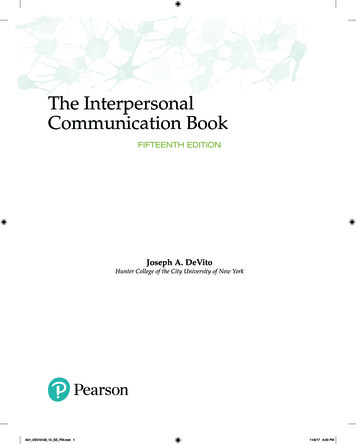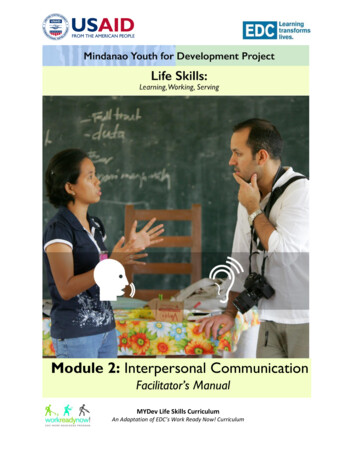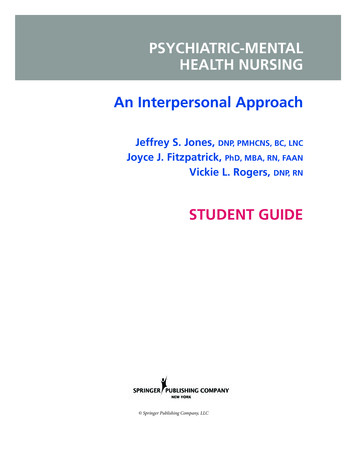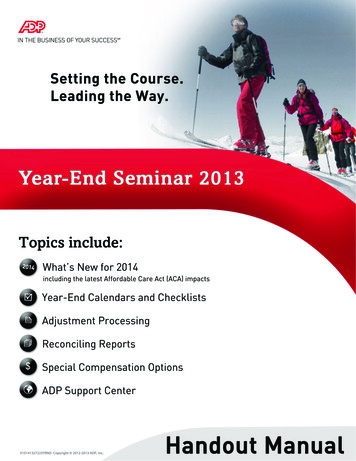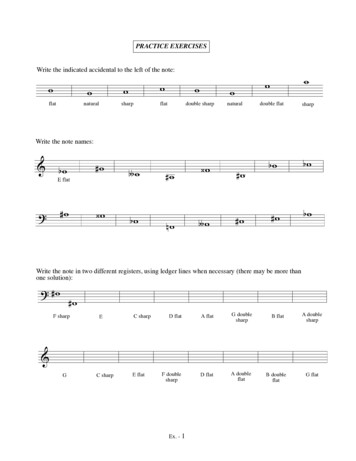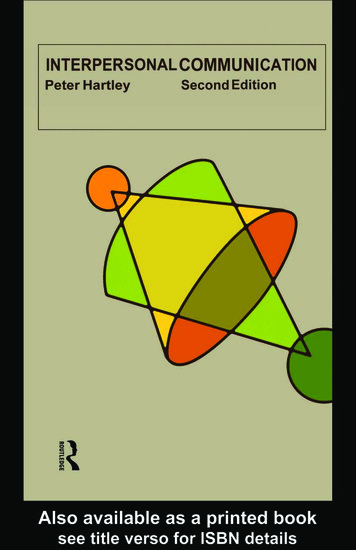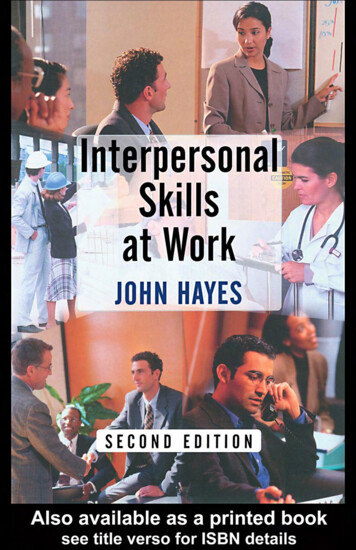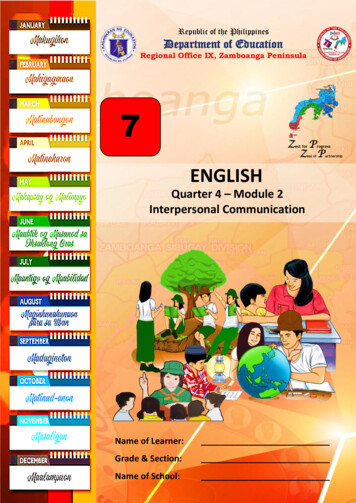
Transcription
Republic of the PhilippinesDepartment of EducationRegional Office IX, Zamboanga Peninsula7Zest for ProgressZ Peal ofartnershipENGLISHQuarter 4 – Module 2Interpersonal Communication(Interview, Dialog, Conversation)Name of Learner:Grade & Section:1Name of School:
What I Need To KnowCommunication is a process by whichinformation is exchanged betweenindividuals through a common system ofsymbols, signs, or behavior.It is essential in our everyday activities,and is required in order to function in anyaspect of life. It is considered to be adynamic or an ongoing process wherepeople understand each other and where ashared meaning is created.Our greatest delight in our dailyundertakings depends on our closerelationship with our fellowmen, likewise,our successful existence depends on ourinterpersonal communication.MELCS: Employ a variety of strategies for effective interpersonal communication(interview, dialog, conversation) - (EN7OL-I-b1.14)Learning Objective: Discuss Dyadic communication as a basic form of InterpersonalCommunication.1
What I KnowActivity 1: Word PuzzleDirections: Study the word puzzle below. List down at least five words which are related tothe word ’s InActivity 2. Fact or Bluff?Directions: Read the following sentences carefully. Write T if the statement is True and F if False.1. Various nervous mannerisms should be avoided in an interview.2. Communication is essential in everyday activities of human being.3. Cheerful physical surroundings should not be considered in an interview process.4. An interview is the most intimate talk of any kind between two persons.5. In the process of interview, argumentation is essential.6. Dialogue is a tedious speech by one person during a conversation.7. Keeping the purpose of an interview constantly in mind is vital.8. Conversation is an informal talk between two or more people in which news and ideasare exchanged.9. Verbal manifestation and disapproval in an interview should be avoided.10. Interview is a “pre-arranged” face to face conversation between two people.2
What’s NewActivity 3. Guess the PictureDirections: Look at each picture closely and observe what does each illustrate? Citereason(s) in coming up with your conclusion.This picture shows a/an ,Reason(s):This picture shows a/an ,Reason(s):This picture shows a/an ,Reason(s):3
What Is ItDyadic Communication refers to communication between two individuals who areresponding to each other to simultaneously influence and be influenced, which is a part ofdeveloping social relationship.Likewise, a dyad, which is an encounter or conversation between two persons, is consideredas the basic form of interpersonal communication.FORMS OF DYADIC COMMUNICATION1. Conversation is the most common form of dyadic communication. It may be definedas a friendly and usual informal talk between two people who exchange their views and ideas.2. Dialogue is the most personal and intimate form of dyadic communication. It is a talk of anykind between you and your friend that brings magic, eradicating the factors which divide orhinder communication between the two of you.3. Interview is a form of dyadic communication that is considered a two-way process where bothparties alternately talk and listen. It is a conversation with a purpose which aims to help theinterviewee to understand and put into a larger context the interpersonal, social and culturalaspects of the environment.Interviewer- a person who obtains information from another by asking a series of questionsInterviewee- the one who is interviewedTypes of Interviewa. Motivational Interview- involves multiple objectives such as employment screening,creating stories, counseling, receiving complaints and connecting.b. Structured Interview- involves rapport building which is created by a warm and positiveclimate which reduces anxiety and defensiveness, for it is conducted by the interviewer toextract knowledge, information and data from the respondent.4
What’s MoreScore :5Activity 4. Complete MeDirections: Read the scenario below and supply words to complete the conversation. Chooseonly the appropriate words in the box for your answers.Scene :Tom is having a job interview. Sarah is asking her questions about his work history. CollegeJobIn charge ofBeforeworkedSarah: So Tom, tell me about your current ?Tom: Sure. I work for ABC chemicals.I’m international sales.Sarah: So, how long have you there?Tom:Um, I’ve worked at ABC since 2010.Sarah: Ok. Where did you work ?Tom: I worked for Tenant Research. I was a Junior Analyst.I worked there for five years.Sarah: Was that your first job?Tom: Yes, it was.Sarah: That’s fine. Thank you.5
Activity 5. Rearrange MeDirections: Study the dialogue below. Arrange the jumbled words to form a clear conversation.Example:Amy:Billy/Hi ?Billy:Amy:Billy:Amy:Hi, Billy?Hello/are/you?/ y/Yes,/about /How/you?Billy: yet,/Not/I am/so/now/busyAmy: you/But,/have/it/to getBilly: Sure,/I am/waiting/just/to finish/work/myAmy: you around./Ok,/seeBilly: thanks/Sure,/for your/concern.What I Have LearnedActivity 6. Fill in the BlanksDirections: Read the following statements. Supply word/s to complete it.1. is essential in the everyday activities of human.2. Dyadic communication refers to communication betweenindividuals.3. Conversation is the most form of dyadic communication.4. is the most formal and intimate form of dyadiccommunication.5. is a form of dyadic communication that is considered astwo-way process.6. is a type of interview that involves employment screening,counselling, and others.7. is a type of interview that involves rapport building which iscreated by a warm and positive climate.8. The is the one being asked in an interview.9. One’s successful existence depends on .10. The one who is asking the questions in an interview is called the .6
What I Can DoSCORE :20Activity 7: Think and WriteDirections: Write a conversation using at least five (5) of the phrases given in the box. You canmake an introduction or greetings.free timenice to meet yourepeat thatdo you like ?see you laterfirst namehave a nice dayfavoritetake it easyhow are you ?How about you ?email addressExample :Angelica : Hi, my name is Angelica. What is your first name?Rubrics for Activity 5- Think and WritePoints20DescriptionStudent uses 5 given phrases.Student uses effective strategies to complete the conversation.15Student uses at least 4 given phrases.Student uses appropriate strategies to complete the conversation.10Student uses at least 3 given phrases.Student uses strategies that are ineffective.5Student uses at least 2 given phrases or failed to use any phrase.Student makes no attempt to use a strategy.7
Score :AssessmentDirections: Read each item carefully, then answer the following questions by shading thecorresponding circle of the correct answer.1. Why is communication considered essential to human’s everyday activities?A.B.C.D.It helps a person to talk whatever he/she wantsIt helps a person to develop speaking skillsIt helps a person to express his/her thoughtsIt helps a person to understand others and be understood.2. Which of the following choices is NOT a form of a Dyadic communication?A.B.C.D.ConversationDialog / DialogueGroup ChatsInterview3. Dyadic communication literally involves .A.B.C.D.One person onlyTwo persons onlyThree persons onlyGroup of people4. Which of the following choices is considered as the most common form of Dyadiccommunication?A.B.C.D.ConversationDialog / DialogueMotivational interviewInterview5. Which of the following choices is considered as the most personal and intimate form ofDyadic communication?A.B.C.D.ConversationDialog / DialogueMotivational interviewInterview8
6. Which of the following is TRUE about interpersonal communication?A.B.C.D.It does not require an involvement of more than one personIt can be done aloneIt requires more than one personIt is not essential at all7. Which of the following choices holds the control when conducting an nguage8. Can someone conduct an interview without asking question?A.B.C.D.Yes, interviewing does not require questionYes, talking without questioning can make an interviewNo, questioning is essential in an interviewNo, it can be done sometimes9. The term Dyadic comes from the word Dyad which mean?A.B.C.D.OneTwoThreeFour10. is a process by which information is exchanged betweenindividuals through a common system of symbols, signs, or ning9
Additional Activities (Optional)Activity 8a:Directions: The following are examples of dyadic communication. Choose one (1)that you usually use at home and write about it on the space provided.CONVERSATION10
DIALOGINTERVIEW11
Activity 8-B:Directions: Compare and contrast the following types of an interview using the ew12
Assessment1. D2. C3. B4. A5. B6. C7. A8. C9. B10. CWhat I Can DoActivity 7.Answers may varyWhat’s MoreActivity 41. job2. in charge of3. worked4. before13What’s MoreActivity 51. Hello, how are you?2. I am fine.3. Did you get yourmodules?4. Not yet. I am so busynow.5. But, you have to get it.6. Sure, I am just waitingto finish my work.7. Ok, see you around.8. Sure, thanks for yourconcern.What I Have LearnedActivity 61. Communication2. Two or more3. Common4. Dialogue/Dialog5. Interview6. Motivational Interview7. Structured Interview8. Interviewee9. Interpersonal Communication10. InterviewerAdditional ActivitiesActivity 8-AAnswers may varyAdditional ActivitiesActivity 8-BAnswers may varyWhat’s NewActivity 3Answers may varyWhat’s InActivity 2.1. T2. T3. F4. F5. F6. F7. T8. T9. T10. TWhat I KnowActivity 1.(In any order)1. Interview2. Art3. Message4. Question5. SenderAnswer Keys:
References:Mely M. Padilla, Ligaya C. Bacomong, Hilaria P. Dato-on, Ma. Anniedith B.Rosario, Leticia L. Sabornido, Speech for Effective Communication,“Interpersonal Communication: Its Definition and Nature, ch.6, pp. 157-162,Trinidad publishing Inc.https:/ clipart-library.comMerriam-Webster dictionaryDEVELOPMENT TEAMWriter: Marco David N. CoderaNurhuda M. SattarBasilan National High SchoolEditor:Language Editor:Proof Reader:Sayana S. Hassan, EPSIllustrators:Marco David N. Codera, Nurhuda M. SattarJulienne Izabel A. BuanteLayout Artist: Julienne Izabel A. BuanteManagement Team:Julieto H. Fernandez, Ed. D., CESO VISDS-Isabela CityMaria Laarni T. Villanueva, Ed. D., CESEASDS-Isabela CityHenry R. Tura, CID ChiefElsa A. Usman, LR SupervisorHelen De Leon, EPS-English, Module Coordinator14
Region IX: Zamboanga Peninsula Hymn – Our Eden LandHere the trees and flowers bloomHere the breezes gently Blow,Here the birds sing Merrily,The liberty forever Stays,Gallant men And Ladies fairLinger with love and careGolden beams of sunrise and sunsetAre visions you’ll never forgetOh! That’s Region IXHereHereHereWithHardworking people Abound,Every valleys and DaleZamboangueños, Tagalogs, Bicolanos,thethethetheBadjaos roam the seasSamals live in peaceTausogs thrive so freeYakans in unityFarewell, dear Fatherland, clime of the sun caress'dPearl of the Orient seas, our Eden lost!,Gladly now I go to give thee this faded life's best,And were it brighter, fresher, or more blestStill would I give it thee, nor count the cost.Cebuanos, Ilocanos, Subanons, Boholanos, Ilongos,All of them are proud and trueRegion IX our Eden LandRegion IXOur.Eden.Land.My Final FarewellLet the sun draw the vapors up to the sky,And heavenward in purity bear my tardy protestLet some kind soul o 'er my untimely fate sigh,And in the still evening a prayer be lifted on highFrom thee, 0 my country, that in God I may rest.On the field of battle, 'mid the frenzy of fight,Others have given their lives, without doubt or heed;The place matters not-cypress or laurel or lily white,Scaffold or open plain, combat or martyrdom's plight,T is ever the same, to serve our home and country's need.Pray for all those that hapless have died,For all who have suffered the unmeasur'd pain;For our mothers that bitterly their woes have cried,For widows and orphans, for captives by torture triedAnd then for thyself that redemption thou mayst gainI die just when I see the dawn break,Through the gloom of night, to herald the day;And if color is lacking my blood thou shalt take,Pour'd out at need for thy dear sakeTo dye with its crimson the waking ray.And whe n the d ark nig ht wr ap s the gr ave y ar d ar oundWith only the d e ad in the ir v ig il to s e eB re ak not m y re p os e or the m ys tery p r of oundAnd pe rc hanc e thou m ays t he ar a s ad hym n re s ound' T is I, O my c ountry, r aising a s ong unto the e .My dreams, when life first opened to me,My dreams, when the hopes of youth beat high,Were to see thy lov'd face, O gem of the Orient seaFrom gloom and grief, from care and sorrow free;No blush on thy brow, no tear in thine eye.And ev e n my g rav e is r em em be re d no m oreUnm ark 'd by ne ve r a c r os s nor a stoneLe t the plow s we ep thr oug h it, the sp ade tur n it o' erThat m y as hes m ay c arp e t e ar thly f loor,B ef ore into nothing nes s at las t the y are b lown.Dream of my life, my living and burning desire,All hail ! cries the soul that is now to take flight;All hail ! And sweet it is for thee to expire ;To die for thy sake, that thou mayst aspire;And sleep in thy bosom eternity's long night.The n will ob liv ion br ing to me no c ar eAs ove r thy v ale s and p lains I s we e p;Thr ob b ing and c le anse d in thy s p ace and airWith c olor and lig ht, with s ong and lame nt I f are ,Ev e r re p e ating the f aith that I k ee p .If over my grave some day thou seest grow,In the grassy sod, a humble flower,Draw it to thy lips and kiss my soul so,While I may feel on my brow in the cold tomb belowThe touch of thy tenderness, thy breath's warm power.M y F athe rland ad or' d, that s ad ne ss to my sor r ow le nd sB e lov ed F ilip inas, he ar now m y las t g ood -b y!I g ive the e all: p are nts and k indr ed and f r iend sF or I g o wher e no s lav e be f or e the op pr es s or b e nds ,Whe r e f aith c an ne ve r kill, and God r e ig ns e ' er on hig h!Let the moon beam over me soft and serene,Let the dawn shed over me its radiant flashes,Let the wind with sad lament over me keen ;And if on my cross a bird should be seen,Let it trill there its hymn of peace to my ashes.F are well to y ou all, f r om m y s oul tor n away,F rie nds of m y c hild hood in the home disp oss e ss ed !Giv e thanks that I re s t fr om the we ar is om e d ay !F are well to the e, too, s we e t f rie nd that lig hte ne d m y way;B e lov ed cre ature s all, f are well! I n d e ath ther e is re s t!I Am a Filipino, by Carlos P. RomuloI am a Filipino–inheritor of a glorious past, hostage to the uncertainfuture. As such I must prove equal to a two-fold task–the task ofmeeting my responsibility to the past, and the task of performing myobligation to the future.I sprung from a hardy race, child many generations removed ofancient Malayan pioneers. Across the centuries the memory comesrushing back to me: of brown-skinned men putting out to sea inships that were as frail as their hearts were stout. Over the sea I seethem come, borne upon the billowing wave and the whistling wind,carried upon the mighty swell of hope–hope in the free abundance ofnew land that was to be their home and their children’s forever.I am a Filipino. In my blood runs the immortal seed of heroes–seedthat flowered down the centuries in deeds of courage and defiance.In my veins yet pulses the same hot blood that sent Lapulapu tobattle against the first invader of this land, that nerved Lakandula inthe combat against the alien foe, that drove Diego Silang andDagohoy into rebellion against the foreign oppressor.The seed I bear within me is an immortal seed. It is the mark of mymanhood, the symbol of dignity as a human being. Like the seedsthat were once buried in the tomb of Tutankhamen many thousandyears ago, it shall grow and flower and bear fruit again. It is theinsignia of my race, and my generation is but a stage in theunending search of my people for freedom and happiness.I am a Filipino, child of the marriage of the East and the West. TheEast, with its languor and mysticism, its passivity and endurance,was my mother, and my sire was the West that came thunderingacross the seas with the Cross and Sword and the Machine. I am ofthe East, an eager participant in its spirit, and in its struggles forliberation from the imperialist yoke. But I also know that the Eastmust awake from its centuried sleep, shake off the lethargy that hasbound his limbs, and start moving where destiny awaits.I am a Filipino, and this is my inheritance. What pledge shall I givethat I may prove worthy of my inheritance? I shall give the pledge thathas come ringing down the corridors of the centuries, and it shall becompounded of the joyous cries of my Malayan forebears when firstthey saw the contours of this land loom before their eyes, of the battlecries that have resounded in every field of combat from Mactan toTirad Pass, of the voices of my people when they sing:“I am a Filipino born to freedom, and I shall not rest until freedomshall have been added unto my inheritance—for myself and mychildren and my children’s children—forever.”15
as the basic form of interpersonal communication. FORMS OF DYADIC COMMUNICATION 1. Conversation is the most common form of dyadic communication. It may be defined as a friendly and usual informal talk
